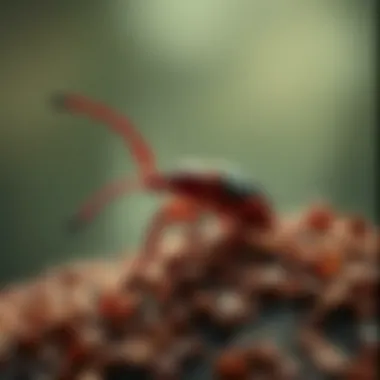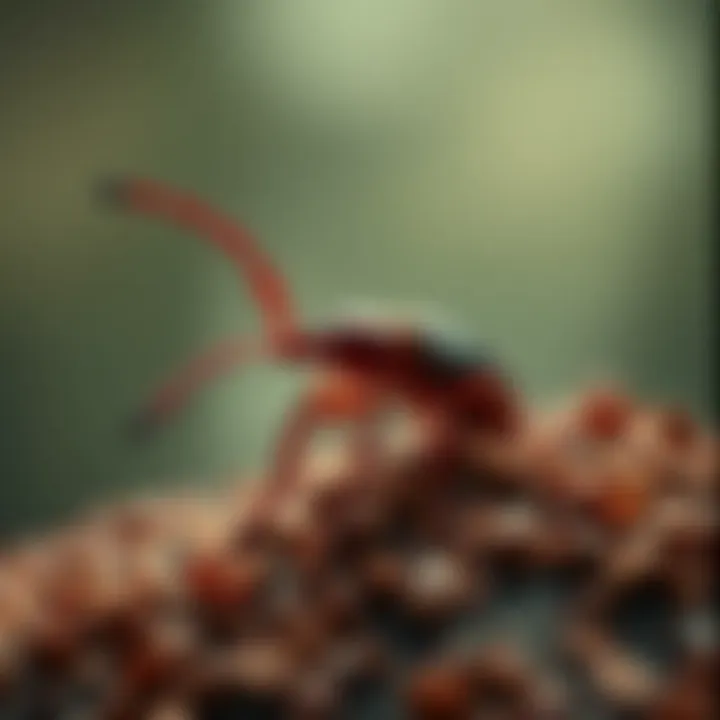Kala Azar: Understanding a Significant Tropical Disease


Intro
Kala Azar, or visceral leishmaniasis, is more than just a name; it's a considerable public health issue lurking in the shadows of global awareness. While diseases like malaria and tuberculosis often steal the spotlight, Kala Azar quietly affects thousands, particularly in regions where healthcare infrastructure is already overburdened. By bringing this neglected tropical disease to the forefront, one can understand its complexities and the imperative nature of combating it.
This article aims to peel back the layers surrounding Kala Azar, exploring its history and epidemiological trends, clinical manifestations, and the wide variety of treatment options available. Furthermore, it highlights the socio-economic factors that significantly influence disease transmission and management. As we traverse these elements, our goal is clear: elevate understanding, promote advocacy, and encourage improved healthcare practices to combat this neglect.
Through integrating research, historical context, and current trends, we aim to foster a comprehensive dialog among students, researchers, educators, and professionals who stand at the intersection of health and policy. It's not just about examining Kala Azar as a single entity; it's about understanding its broader implications and recognizing that each case reflects a more extensive narrative interwoven with social, economic, and health-related threads.
Prologue
Kala Azar, or visceral leishmaniasis, represents a significant yet often overlooked global health challenge. This neglected tropical disease affects many, particularly in impoverished regions, where it remains endemic. The gravity of understanding Kala Azar cannot be overstated, given its potential to cause severe morbidity and, if left untreated, could be fatal. In this article, we will delve into the multifaceted aspects of this disease, not just from a clinical perspective but also its historical backdrop, epidemiology, pathophysiology, and socio-economic implications.
The urgency to shed light on Kala Azar stems from its pervasive presence in countries with minimal healthcare resources. By exploring key elements surrounding the disease, we aim to equip students, researchers, educators, and healthcare professionals with a comprehensive understanding, ultimately advocating for increased awareness and effective interventions.
Through this examination, it becomes clear that knowledge about Kala Azar, including its transmission, symptoms, and treatment options, plays a critical role in mitigating its impact on affected populations. As we navigate through the various sections, a deep understanding of both the disease’s nature and its historical context will serve as a foundation for better insights into the current challenges and future directions regarding prevention and treatment.
The Nature of Kala Azar
Kala Azar is primarily caused by infection with the Leishmania donovani parasite, transmitted by the bite of infected female sandflies, notoriously found in warm, sandy habitats. The disease thrives in regions where conditions enable the sandfly population to flourish, which adds difficulty in managing outbreaks. Once the parasite enters the human body, it affects the organs, particularly the spleen, liver, and bone marrow, leading to severe health complications.
People infected with Kala Azar may experience a range of symptoms, such as prolonged fever, significant weight loss, anemia, and splenomegaly. An increase in bodily symptoms underscores the importance of early detection and intervention. Recognizing these signs is vital, especially in endemic areas where healthcare accessibility is limited.
In essence, understanding the ecological factors influencing Leishmania transmission helps inform effective control strategies. By targeting the vectors and enhancing community awareness, progress can be made in preventing this disease from spreading.
Historical Context
The roots of Kala Azar can be traced back centuries, with records indicating its existence at least as far as the 19th century. It has significantly impacted various regions, primarily in the Indian subcontinent, East Africa, and Latin America. The disease was historically shrouded in mystery, often attributed to malnutrition and poor living conditions, and not clearly linked to its parasitic origins until more modern studies emerged.
In the early 1900s, the causative agent, Leishmania donovani, was identified, leading to a shift in understanding the epidemiology of Kala Azar. Historic campaigns undertaken in the mid-20th century focused on vector control strategies, demonstrating that community engagement plays a crucial role in limiting the spread of this disease. However, as global focus shifted towards other diseases, Kala Azar slipped back into relative obscurity.
The interplay between socio-political factors and healthcare access has woven a complex tapestry in the historical narrative of Kala Azar. Different regions have faced variances in response due to factors like war, poverty, and healthcare infrastructure. Supporting records from various sources, such as WHO, highlight a constant struggle against this disease, necessitating a concerted global effort for eradication.
Epidemiology
The study of epidemiology provides crucial insights into the dynamics of Kala Azar, also known as visceral leishmaniasis. Understanding how, where, and to whom this disease primarily affects is vital for developing effective interventions and public health strategies. Epidemiology reveals trends which may not be immediately apparent through individual case studies, highlighting patterns of spread and identifying populations most vulnerable to infection. Moreover, recognizing the socio-economic backdrop can illuminate why certain regions experience higher incidences, thereby driving more tailored and informed efforts in disease control.
Geographic Distribution
Kala Azar is predominantly found in certain parts of the world, largely within tropical and subtropical regions. The disease is notably more prevalent in countries like India, Bangladesh, Sudan, and Brazil. These regions exhibit environmental conditions that favor the life cycle of Leishmania parasites, transmitted through sandfly bites. To illustrate, endemic areas often suffer from inadequate sanitation and shelter, which affects disease spread through increased sandfly habitats. Moreover, urbanization encroaching upon rural settings complicates the epidemiology as human settlements expand into infected zones.
In India, states like Bihar and Jharkhand are hotspots, where socio-political factors mingle with environmental ones—leading to increased transmission rates. Mapping these areas helps health officials strategize targeted interventions, making geography an indispensable component in managing Kala Azar.
Population at Risk
Individuals at higher risk for Kala Azar include marginalized communities often living in poverty. This demographic is frequently characterized by limited access to healthcare, sanitation, and proper nutrition. Factors such as malnutrition and other co-existing diseases—like HIV/AIDS—can exacerbate vulnerability. As a result, understanding socio-economic factors paints a vivid picture of risk beyond mere biological susceptibilities.
In addition to these concerns, certain populations, including children and immunocompromised individuals, are more prone to severe manifestations of the disease if infected. It is critical for health strategies to take these populations into account, as they require specific prevention tactics and treatment approaches that are sensitive to their distinct needs.
Seasonal Variations in Incidence
Seasonality plays a significant role in the incidence of Kala Azar, with fluctuations tied closely to environmental changes. The rainy season, for instance, creates favorable breeding conditions for sandflies, leading to increased transmission. In regions with pronounced wet and dry seasons, peaks in cases during monsoon months can be observed. Conversely, dry seasons might witness a decline in infections.
Researchers have noted that these seasonal patterns are not uniform globally. Factors like local climate, agricultural practices, and even cultural habits around cleaning and sanitation can variably impact how Kala Azar is transmitted in different areas.
Overall, understanding the seasonal dynamics compels the need for timely public health alerts and resource allocation to combat surges in cases.
"By digging into the layers of epidemiology, we can arm ourselves with the knowledge to combat Kala Azar effectively, and shift the narrative from neglect to containment."
"By digging into the layers of epidemiology, we can arm ourselves with the knowledge to combat Kala Azar effectively, and shift the narrative from neglect to containment."
Pathophysiology
Understanding the pathophysiology of Kala Azar is crucial because it lays the groundwork for grasping how this disease impacts human health. The interplay between the Leishmania parasites and the human immune system results in a myriad of clinical manifestations, which can be severe if not addressed timely. In this exploration, we delve into the intricacies of the parasites involved and elucidate the immune mechanisms that contribute to disease progression.
Leishmania Parasites
Leishmania is not just a singular entity; it encompasses various species, most notably Leishmania donovani and Leishmania infantum, which are responsible for causing visceral leishmaniasis, or Kala Azar. These parasites belong to the genus Leishmania, transmitted primarily through the bites of infected female sandflies. Once they enter the host, they invade macrophages, which are crucial immune cells that normally digest and destroy pathogens. Instead of being destroyed, the parasites proliferate within these cells, evading immune responses.
The Leishmania life cycle is complex and often requires a suitable vector, which not only aids in its transmission but also essentially acts as a host to the parasite during part of its life cycle. Notably, the ability of these parasites to alter macrophage functionality is a double-edged sword; while aiding their survival, it also contributes to the host's response.
Key Features of Leishmania Parasites:
- Morphological Diversity: They can exist in both promastigote (flagellated) and amastigote (non-flagellated) forms.
- Intracellular Survival: Their ability to withstand the harsh conditions within macrophages makes treatment a challenge.
- Genetic Variation: Different species can exhibit diverse pathogenic profiles, influencing disease severity in humans.
Immune Response and Pathogenesis
The intricate dance between Leishmania and the immune system is where the pathogenesis of Kala Azar unfolds. When a person becomes infected, the immune system's first response includes the activation of macrophages, which seek to eliminate the parasites. However, Leishmania employs various strategies to thwart this response. For instance, it secretes proteins that interfere with macrophage function, effectively silencing the immune attack.
Moreover, the immune response elicited by this infection is often inadequate. A critical player in the immune response is the T-cell, particularly CD4+ T-helper cells. These cells are essential for orchestrating an effective immune response, but in the case of Kala Azar, the immune system often defaults to a T response instead of the necessary T response that can effectively combat the infection.


Important Aspects of the Immune Response:
- Role of Cytokines: Chemokines and other immune signaling molecules help to regulate the immune response, but a skewed cytokine profile can hinder effective fighting of the infection.
- Immunosuppression: Chronic infection can lead to an exhaustion of immune responses, giving the parasites a free rein to multiply and cause systemic issues.
- Impact on Bone Marrow: The disease can interfere with normal hematopoiesis, leading to anemia and other related complications.
Understanding how Leishmania infects and manipulates the immune system is essential for developing effective treatments and preventing disease spread.
Understanding how Leishmania infects and manipulates the immune system is essential for developing effective treatments and preventing disease spread.
In summary, the pathophysiology of Kala Azar showcases the delicate interplay between parasite and host, illuminating the pathway from infection to disease severity. As research continues to unfold, recognizing these mechanisms will be pivotal in implementing successful interventions and therapeutic strategies.
Clinical Manifestations
Understanding clinical manifestations is crucial when discussing Kala Azar, a disease that often slips under the radar. This section will explore the symptoms and complications associated with the disease, illuminating their implications on both individual patients and broader public health contexts.
Symptoms and Signs
Kala Azar manifests insidiously, often leading to a delay in diagnosis. Initial symptoms can easily be mistaken for common ailments: fever, fatigue, and weight loss. As the disease progresses, its clinical picture becomes more pronounced. Common symptoms include:
- Fever and chills: Persistent fever, often intermittent, is characteristic. Patients may feel cold and shivery before the fever spikes, leading to confusion about accompanying conditions.
- Weight loss: Rapid and involuntary weight loss is typical, resulting from metabolic disturbance and increased catabolism as the body tries to fight the infection.
- Splenomegaly: The enlargement of the spleen is a notable sign, visible during physical examinations. It's a critical indicator often assessed in suspected cases.
- Anemia and leukopenia: These hematological anomalies are common, as the disease impacts bone marrow function, leading to decreased production of red blood cells and white blood cells.
- Skin manifestations: Although not as common as in cutaneous leishmaniasis, some patients may develop skin lesions or rashes, which can add to the diagnostic dilemma.
A patient might comment on feeling “like a shadow of their former self,” which captures the debilitating nature of these symptoms. Moreover, fatigue often leads patients to shun daily activities, impacting their quality of life significantly.
Complications and Co-Infections
Kala Azar is not just a standalone illness; it can set the stage for a suite of complications and co-infections that can further complicate treatment and patient recovery. Some of the notable complications include:
- Secondary infections: The compromised immune system opens the door to other infections, which can be fatal if not managed effectively. Tuberculosis and HIV are common culprits in co-infected populations.
- Severe anemia: As noted earlier, the disease can drive anemia to critical levels, necessitating blood transfusions and other intensive interventions.
- Hemorrhagic manifestations: Internal bleeding may occur, particularly in cases where liver function is severely compromised. This can lead to life-threatening situations requiring immediate medical attention.
- Post-kala-azar dermal leishmaniasis (PKDL): A long-term complication where skin lesions develop, this condition can emerge months to years post-treatment, further complicating care and impacting the psychosocial well-being of patients.
The relationship between Kala Azar and other conditions such as HIV is particularly concerning. A person living with HIV might find that their resistance to infections is significantly lower, making them more susceptible to Kala Azar and its complications. This interplay between diseases highlights the need for integrated health policies that consider co-morbidity when addressing tropical diseases like Kala Azar.
Understanding the clinical manifestations of Kala Azar allows health professionals to make precise diagnoses, which is vital for effective treatment and management strategies.
Understanding the clinical manifestations of Kala Azar allows health professionals to make precise diagnoses, which is vital for effective treatment and management strategies.
These symptoms and complications underscore the complexity surrounding Kala Azar. Awareness plays a pivotal role, and understanding these clinical manifestations is an essential first step toward efficient treatment pathways and preventive measures. For more information on the disease and treatment strategies, visit CDC or World Health Organization.
Diagnosis
Diagnosis of Kala Azar plays a critical role in managing this neglected tropical disease. Accurately identifying the disease is the first step in ensuring that patients receive appropriate treatment, which can be life-saving. Early diagnosis can prevent complications, reduce transmission, and improve patient outcomes. Hence, delving into the methods used for this task helps us understand the scope and importance of timely identification.
Clinical Diagnosis
In clinical settings, diagnosing Kala Azar relies heavily on the recognition of symptoms and the patient's history. Symptoms often overlap with other conditions, making it a puzzle for healthcare professionals. Classical clinical signs include prolonged fever, weight loss, and splenomegaly, but these can be subtle and easily mistaken for other diseases, particularly in endemic areas. A careful inquiry into a patient’s travel history and potential exposure areas is crucial.
When a healthcare provider suspects Kala Azar, they often perform a physical examination focusing on potential swellings and weight changes. The challenge lies in the fact that some patients may not exhibit clear symptoms until the disease has advanced, underscoring the importance of routine screening in high-risk populations. Despite the challenges, clinical diagnosis remains a frontline approach in areas where laboratory resources are scarce.
Laboratory Techniques
Serological Methods
Serological methods stand out as a pivotal approach for confirming Kala Azar. They detect antibodies against the Leishmania parasites, allowing identification of infections even during the asymptomatic phase. A key defining trait is the relatively straightforward nature of these tests, which can often be done at the point of care. The rapid results provide invaluable information, making serological testing a popular choice in resource-limited settings.
However, it is essential to note that while serological assays are beneficial, they can sometimes yield false positives due to cross-reactivity with other infections. It's critical for healthcare workers to be aware of this nuance. Moreover, serological methods may not differentiate between current and past infections, which can complicate treatment decisions.
Molecular Techniques
Molecular techniques, including polymerase chain reaction (PCR), represent a leap forward in diagnostic accuracy, specifically in the detection of Leishmania DNA from various samples. The primary advantage lies in their high sensitivity and specificity, which can confirm active infections even in subtle clinical presentations. Their ability to provide precise identification of species also enhances epidemiological understanding and tailoring of treatment strategies.
On the other hand, molecular methods often require more sophisticated equipment and trained personnel, which can pose a barrier in under-resourced areas. Additionally, these techniques can be cost-prohibitive and time-consuming compared to serological tests, impacting their availability in smaller healthcare settings.
Microscopic Examination
Microscopic examination of body fluids, particularly bone marrow or spleen aspirates, remains a standard method for diagnosing Kala Azar. This technique allows direct visualization of the Leishmania parasites. It's a relatively straightforward process, making it accessible for many healthcare providers.
A crucial characteristic of this method is its capacity to provide immediate evidence of infection, which can be beneficial for rapid treatment initiation. However, one significant drawback is the invasive nature of the procedure, which may deter some patients or be impractical in certain settings. Additionally, it can miss low levels of parasitic presence, leading to false negatives in cases where the parasite burden is not high.
In summary, while clinical diagnosis initiates the journey toward managing Kala Azar, laboratory techniques provide the necessary confirmation required for effective intervention. Each method carries its pros and cons, highlighting the need for a multi-faceted diagnostic approach.
In summary, while clinical diagnosis initiates the journey toward managing Kala Azar, laboratory techniques provide the necessary confirmation required for effective intervention. Each method carries its pros and cons, highlighting the need for a multi-faceted diagnostic approach.
Further reading on laboratory techniques in infectious disease can be explored at CDC.gov, and you may also find detailed insights applicable specifically to Kala Azar on Wikipedia.
Treatment Options
The treatment of Kala Azar is paramount for mitigating the public health crisis it presents in various parts of the world. Given the complexities involved in the disease's pathology and epidemiology, the treatment landscape is multifaceted. Effective treatment options not only help in the recovery of affected individuals but also play a critical role in reducing transmission rates and preventing further outbreaks.
Choosing the appropriate treatment involves considering various factors, including the stage of the disease, the patient's health condition, access to healthcare resources, and the potential side effects of medications. This section delves into the primary classes of treatments available for Kala Azar, highlighting key elements, benefits, and considerations for each.
Antimonial Compounds
Antimonial compounds, particularly sodium stibogluconate and meglumine antimoniate, have been the cornerstone of Kala Azar treatment for decades. These compounds belong to a class of drugs known as pentavalent antimonials.


- Efficacy: Historically, these drugs have demonstrated good efficacy, yielding high cure rates in otherwise healthy individuals.
- Administration: Antimonial compounds are typically administered via intravenous or intramuscular injections, requiring healthcare facilities for monitoring.
- Side Effects: Patients might experience a range of side effects, including nausea, vomiting, and potential cardiotoxicity, thus necessitating careful patient selection and monitoring throughout treatment.
While they have been effective, emerging resistance to antimonials, particularly in high-endemic areas, raises concerns regarding their long-term viability as primary options for treatment. This underscores the need for ongoing research and the development of alternative therapies.
Amphotericin B
Amphotericin B is an antifungal agent that has shown promise in treating Kala Azar, especially amongst those cases that are resistant to antimonial therapy.
- Broader Efficacy: This drug acts by disrupting fungal and some parasite cell membranes, leading to cell death. Its broad-spectrum efficacy makes it a valuable alternative.
- Application: Usually administered in a hospital setting due to the potential for severe side effects, including infusion reactions and nephrotoxicity.
- Types: There are formulations of Amphotericin B, with Liposomal Amphotericin B being preferred due to its reduced side effects profile and improved efficacy in severe cases.
Despite its strengths, Amphotericin B is not without challenges. The high cost of treatment and the necessity for specialized healthcare infrastructure can be barriers for many patients in endemic regions.
Miltefosine and Other Treatments
Miltefosine represents a breakthrough oral option for treating Kala Azar, offering a more accessible means of therapy compared to injectable options.
- Convenience: Patients can take this medication orally, improving adherence and reducing the need for hospital visits.
- Success: Clinical trials have shown that Miltefosine can achieve high cure rates, and its effectiveness against Leishmania donovani, the causative agent of Kala Azar, is well-documented.
- Considerations: However, it is not free from drawbacks; potential side effects, including gastrointestinal disturbances and teratogenic effects, impose cautions on its use, especially in women of childbearing age.
Aside from these primary treatments, ongoing research is exploring combination therapies, such as using antimonials with Miltefosine, as well as new compounds derived from natural sources. Emphasizing these alternatives may pave the way for more comprehensive treatment modalities.
Understanding the various treatment options for Kala Azar is crucial not only for individual patient care but also for public health strategies aimed at controlling this neglected tropical disease.
Understanding the various treatment options for Kala Azar is crucial not only for individual patient care but also for public health strategies aimed at controlling this neglected tropical disease.
By examining these treatments, we can better appreciate the challenges faced in managing Kala Azar. As the landscape of treatment continues to evolve, staying informed about advancements will be key.
For further reading on the complexities surrounding these treatment options, useful resources can be found at World Health Organization, Centers for Disease Control and Prevention, and PubMed Central.
Prevention and Control
When it comes to tackling the burden of Kala Azar, understanding prevention and control strategies is of utmost importance. This knowledge can not only help in mitigating the disease's spread but also boost global health efforts geared towards neglected tropical diseases. The combination of effective vector control and the potential for vaccination forms the backbone of tackling this health menace.
Effective prevention hinges on a few core strategies that, when executed well, can greatly diminish the incidence of Kala Azar. These methods address both environmental factors and individual behavior, ensuring that communities are equipped to protect themselves from the disease.
Vector Control Strategies
One of the most critical aspects of preventing Kala Azar involves managing its primary vector—the Phlebotomus sand fly. This insect plays a pivotal role in transmitting the Leishmania parasites to humans. Without an effective strategy to control sand fly populations, tackling Kala Azar remains a daunting challenge.
Several vector control strategies have emerged:
- Environmental Management and Modifications: This involves altering the environment to make it less suitable for sand flies. Proper sanitation and waste disposal can reduce breeding sites. Regular cleaning of potential refuges, such as vegetation near human dwellings, is essential.
- Insecticide Spraying: Utilizing residual insecticides in areas where vectors are prevalent can significantly curtail sand fly populations. Indoor residual spraying (IRS) has proven to be an effective method in many regions.
- Use of Bed Nets: In regions where Kala Azar transmission risks persist, the distribution of insecticide-treated bed nets can provide a protective barrier against bites. These nets should be promoted and provided, especially in high-risk areas.
- Public Education Campaigns: Educating communities about the importance of preventive measures is vital. Awareness programs can empower individuals to undertake essential health practices that minimize exposure to sand flies.
Implementing these strategies in tandem can create an environment where the disease can be more effectively controlled. However, coordination among health authorities, community leaders, and international health organizations is crucial to ensure sustainability and comprehensive coverage.
Vaccination Developments
The potential for a vaccine against Kala Azar is a beacon of hope in the sphere of prevention and control. While research is still ongoing, several promising developments are worth discussing. Historically, vaccine development for Kala Azar has faced many hurdles, mainly due to the complex life cycle of Leishmania parasites and their interactions with the human immune system.
Recent advancements have led to:
- Candidate Vaccines: Several candidate vaccines are currently undergoing different phases of clinical trials. These include whole-killed cell vaccines and recombinant protein-based vaccines that aim to elicit a robust immune response against the parasite.
- Targeting Immunogenic Components: Research has focused on identifying immunogenic components of Leishmania that could be effectively included in vaccine formulations. Screening for potent antigens and adjuvants, which can enhance the immune response, is crucial.
- Public-Private Partnerships: Collaborative efforts between government, NGOs, and pharmaceutical companies have the potential to accelerate the development timeline and ensure that successful vaccines are accessible to the communities that need them the most.
Nevertheless, the road to a widely available and effective vaccine is riddled with challenges. Ongoing funding, as well as a commitment to research, will be vital in making preventive vaccination a reality for at-risk populations. The combined strategies of vaccination and vector control can create a comprehensive preventive framework, reducing not only incidence rates but also the long-term impact Kala Azar has on vulnerable communities.
"The synergy of innovative treatments and comprehensive prevention strategies is our best bet against Kala Azar."
"The synergy of innovative treatments and comprehensive prevention strategies is our best bet against Kala Azar."
In summary, prioritizing prevention through vector control and investing in vaccine development is crucial for reducing Kala Azar's footprint in endemic regions. This coordinated approach not only requires the engagement of health professionals but also the active participation of communities in both prevention and advocacy efforts.
Socio-Economic Factors
The socio-economic aspect of Kala Azar is crucial in understanding how this neglected tropical disease persists in various settings. The interplay between poverty, healthcare access, and community awareness shapes the disease's burden and its impact on public health. Decoding these layers can provide insights into not just prevention but also effective intervention strategies.
Impact of Poverty on Disease Transmission
Poverty plays a significant role in the transmission of Kala Azar. In regions where economic instability reigns, the likelihood of disease spread increases significantly. Low-income areas often lack adequate housing, sanitation, and nutritional resources—environmental factors that enable the proliferation of the Leishmania parasite’s vector: the sandfly.
In many rural communities, limited financial resources make it difficult for residents to invest in protective measures, such as insecticide-treated bed nets or household modifications that deter sandflies. This creates a vicious cycle: poverty heightens vulnerability to Kala Azar, while the disease further entrenchers families in economic hardship. The World Health Organization suggests poverty-tied health challenges lead to poor health literacy, making effective intervention less likely.
Moreover, here are a few insights on how poverty directly influences the disease:
- Limited access to clean water and sanitation promotes environments conducive to sandfly breeding.
- Under-nutrition compromises the immune response, increasing susceptibility to infections, including Leishmania.
- Inadequate healthcare infrastructure hampers early diagnosis and treatment, significantly raising mortality rates.
Understanding this relationship not only informs health policies but also underscores the necessity of tackling poverty as part of Kala Azar control efforts.
"Poverty is the mother of all ailments, and Kala Azar is one of its dreadful offspring.”
"Poverty is the mother of all ailments, and Kala Azar is one of its dreadful offspring.”


Healthcare Access and Disparities
Access to healthcare is another crucial factor influencing Kala Azar’s burden. In many endemic regions, especially those impacted by socio-economic challenges, healthcare services often fall short. Insufficient healthcare infrastructure can mean a lack of trained professionals or the absence of critical diagnostic tools. As a result, patients may not receive timely or effective treatment.
Disparities in healthcare access exist not only within counties but also between rural and urban areas. Those living in rural communities face greater challenges. Long travel distances to health facilities, combined with the costs associated with transport and treatment, often deter seeking care.
Here are a few factors related to healthcare access and its disparities:
- Availability of Services: Health services are frequently scarce in rural areas, limiting access to necessary treatments for affected populations.
- Awareness and Education: Individuals in low-income settings might lack awareness about Kala Azar, contributing to delayed treatment and diagnosis.
- Quality of Care: Even where healthcare facilities exist, they may not have the necessary resources or trained professionals, compromising the quality of diagnosis and treatment.
Efforts to bridge these healthcare gaps are paramount in the fight against Kala Azar. Community engagement, improved health infrastructure, and targeted awareness campaigns can enhance access to healthcare and ultimately reduce disease transmission.
In summary, socio-economic factors play a vital role in the persistence and management of Kala Azar. Addressing poverty and improving healthcare access can help weave a supportive framework, allowing affected populations to combat this disease more effectively.
Current Research Trends
The world of medical research is like a constantly shifting sand dune, with progress often difficult to navigate. When it comes to kala azar, or visceral leishmaniasis, staying vigilant and updated on current research trends is not just beneficial—it's essential. The insights gleaned from ongoing studies can direct healthcare policies, treatment protocols, and preventive measures, ultimately influencing patient outcomes and community health. Not just dusty old findings, this research breathes new life into our understanding of the disease.
Epidemiological Studies
At the core of understanding kala azar lies epidemiological studies, which serve as a roadmap for public health actions. These studies help identify how, where, and why kala azar spreads. Researchers are increasingly focusing their attention on high-risk regions, often found in South Asia, East Africa, and parts of Brazil.
Through the lens of epidemiology, one can see the pockets of vulnerability. For instance, in certain districts of Gujarat, India, the prevalence can be staggering, as these areas struggle with poor sanitation and lack of access to healthcare services. Recent studies underscore the importance of mapping out transmission dynamics, pinpointing seasonality, and determining the vector behavior to control outbreaks.
Interestingly, the shift towards a more integrated approach is on the rise. For example, epidemiological research now often collaborates with social scientists to understand how socio-economic factors like poverty affect the spread. This kind of interdisciplinary study offers richer insights and enhances the development of targeted interventions that are more than mere band-aids.
Innovative Treatment Approaches
On the treatment front, researchers are tirelessly scouring for innovative solutions that can tackle this age-old foe. Antimonial compounds have been the gold standard for decades, but the world is not resting on its laurels. Innovative treatment approaches are crucial, especially in the light of emerging resistance patterns.
One notable trend is the exploration of new drug candidates, such as MILTEFOSINE. Though it first gained attention as an oral option for treating leishmaniasis, its widening use demands continual evaluation for efficacy and safety. Aside from standard treatments, researchers are also turning to combined therapies. For instance, the pairing of Amphotericin B with miltefosine could potentially offer a powerful method to improve treatment success rates, particularly in cases that are resistant to traditional therapies.
Moreover, vaccine development is on the horizon. Current trials are not just theoretical; they’re progressing towards producing practical vaccines that could offer long-term protection. Such breakthroughs could drastically change the landscape of kala azar management.
"The landscape of kala azar treatment is evolving; staying ahead of resistant strains through innovative therapies is crucial for public health." – Dr. Maria L. Sebastian, Infectious Diseases Specialist.
"The landscape of kala azar treatment is evolving; staying ahead of resistant strains through innovative therapies is crucial for public health." – Dr. Maria L. Sebastian, Infectious Diseases Specialist.
In summary, both epidemiological studies and innovative treatments play pivotal roles in advancing our response to kala azar. It's about time we cast the spotlight on this neglected tropical disease, ensuring that the ongoing research translates into actionable strategies that create tangible health improvements globally.
Advocacy and Future Directions
Advocating for enhanced approaches to Kala Azar awareness and treatment is paramount. This neglected tropical disease has often been overshadowed by other public health concerns, but those affected know all too well the deep social and economic impacts it brings. Efforts in advocacy are not just about raising awareness but also about mobilizing resources, strengthening healthcare systems, and implementing effective prevention strategies.
Global Health Initiatives
Global health initiatives play a vital role in the battle against Kala Azar. Organizations such as the World Health Organization (WHO) and Médecins Sans Frontières (MSF) are deeply involved in steering efforts to tackle the disease. Their contributions include:
- Funding for research into more effective treatments
- Supporting vaccination trials that can provide a long-term solution
- Advocating for policy changes through national and international discussions
As stated by the WHO, the aim is not only to address the existing burden of the disease but also to prevent its further spread. This proactive approach can vastly improve healthcare infrastructure in endemic regions, ensure better disease management, and ultimately save lives. Significant partnerships between governments, NGOs, and private sectors are crucial to realizing these goals.
The Role of Community Engagement
Community engagement is another cornerstone of successful Kala Azar advocacy. In places where the disease is endemic, local populations often bear the brunt of ignorance surrounding it. Many community members are unaware of transmission routes, symptoms, and available treatments, leading to delays in seeking help.
Efforts to engage communities include:
- Educational workshops that inform residents about disease prevention and management
- Mobilizing local groups to become advocates within their own communities
- Initiatives to reduce stigma around the disease, empowering patients to seek treatment without fear of judgment
Implementing these community-led initiatives can catalyze change from within, allowing knowledge to proliferate organically. Local engagement not only increases access to education but also enhances the trust between healthcare providers and communities—an essential component in ensuring effective disease control and management.
"Many hands make light work."
By involving communities directly, we empower them to take part in their health journey, leading to better outcomes in managing Kala Azar and other intertwined health issues.
"Many hands make light work."
By involving communities directly, we empower them to take part in their health journey, leading to better outcomes in managing Kala Azar and other intertwined health issues.
Epilogue
In wrapping up this exploration into Kala Azar, it becomes clear that this condition is often sidelined in discussions of global health. The implications of this disease are profound, impacting not only the individuals afflicted but also entire communities and health systems. Understanding the key takeaways from this article is critical in fostering greater awareness and advocacy efforts.
Summary of Key Findings
A deep dive into the various aspects of Kala Azar reveals several critical insights:
- Epidemiology: The distribution of Kala Azar varies globally, with particular hotspots identified in the Indian subcontinent, East Africa, and parts of South America. Data indicates that environmental changes, urbanization, and population displacement worsen outbreaks.
- Pathophysiology: The Leishmania parasites responsible for Kala Azar evade the immune response, leading to severe clinical manifestations if untreated. The understanding of immune responses is crucial to therapeutic advancements.
- Diagnosis and Treatment: Successfully diagnosing Kala Azar remains a challenge due to its nonspecific clinical symptoms. Current laboratory techniques, while improving, still require enhancement for widespread application in endemic regions. Treatment options have advanced but are often hindered by accessibility and affordability.
- Social Impact: The nexus between poverty and disease transmission is particularly alarming, as individuals from lower socio-economic backgrounds face barriers to healthcare access. Implementing targeted interventions can mitigate this disparity.
- Current Trends: Ongoing research into epidemiological patterns and innovative treatments shows promise, but sustained funding and support are essential for these efforts to take root and flourish.
Call for Increased Awareness
Addressing Kala Azar is not just a medical issue; it is a humanitarian cause. Awareness must be raised at multiple levels, including:
- Public Education: Informing communities about the symptoms, transmission, and prevention techniques can empower individuals to seek timely medical attention.
- Advocacy: Governments and health organizations need to prioritize funding for Kala Azar research and treatment options. Attention should be given to tailoring strategies to fit the unique contexts of affected regions.
- Collaborative Efforts: Partnerships among global health initiatives, local governments, and NGOs can foster a holistic approach to combating Kala Azar. This synergy can lead to effective strategies and allocation of resources.
- Research Investment: Increased investment in innovative solutions, whether through vaccines or better diagnostic tools, is essential to eradicating this neglected tropical disease.
"The long-term solution to controlling Kala Azar lies not just in medical intervention but in the upliftment of communities affected by it."
"The long-term solution to controlling Kala Azar lies not just in medical intervention but in the upliftment of communities affected by it."
Without concerted efforts and engagement, the threats posed by Kala Azar will continue to linger in the shadows of global health discussions. By capitalizing on the findings detailed throughout this article, there is potential for significant strides toward comprehensive management and, ultimately, eradication of this disease.



